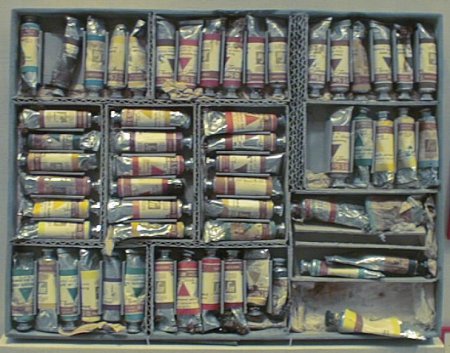Oil Paint in Tubes
Today, we see what happened when we put oil paint in tubes. The University of Houston's College of Engineering presents this series about the machines that make our civilization run, and the people whose ingenuity created them.
Oil painting is about 600 years old. It reached a fine perfection with the Dutch Masters. They'd made oil painting very popular by 1650. But artists still needed the training of a chemical engineer to mix their paints.
So art became associated with alchemy. Physicians and artists both used the same ingredients. Paints were laced with a physician's remedies -- mercury, oils, ivory, and so on. Painters bought their materials at apothecary shops. They even shared the same patron saint with doctors. That was St. Luke.
By the 1700s the demand for oil paints had led to new subspecialties among painters. The colourman now mixed paint and sold it to artists. He radically changed the business of oil painting. For example, specialized portrait painters used those premixed paints in large shops. One such painter might do three oils of the same subject at once.
While the colourman played a part in professionalizing painting, he also helped give birth to the amateur painter. With premixed paint, anyone could go off on his own.
And what do amateurs always do? They experiment. They create mutations. They drive change. So, while the new technologies for containing paint drove amateurs, amateurs drove painting.
Colourmen sold the first premixed paints in pig's bladders. Then they sold paint in syringes -- rather like grease-guns. By 1800 you could buy oil paint in tin tubes. Painters in the Romantic period could pack off to the country to paint rainbows, sunsets, and haystacks. They were free to capture the moment.
As cameras appeared, painters had to redefine their own purpose. Equipped with really portable oils, they changed the game. Instead of reporting the world objectively, they gave us their self-expressive response to a far more fluid world.
Still, the new tube paints had problems. The ingredients that gave paint a toothpaste texture also made it turn yellow over time. The impressionists craved a brilliance they couldn't find in a tube. They went back to relearn paint-making.
Van Gogh experimented with bright, thick-textured paints. He sometimes failed. But he honed the new Impasto technique -- often painting with a knife instead of a brush. And in Van Gogh we read, once more, the terrible complexity of technological change.
For if putting paint in tubes gave rise to Van Gogh, Van Gogh knew he had to go back to invention. To finish the very revolution that spawned him, he had to become an amateur once more. He had to reinvent the technology of painting before he could invent a new vision of the world for all of us to see.
I'm John Lienhard, at the University of Houston, where we're interested in the way inventive minds work.
(Theme music)
Mayer, R., The Artist's Handbook. 5th ed., New York: Viking, 1991, see especially pp. 190-195.
Stephenson, J., The Materials and Techniques of Painting, New York: Watson-Guptill Pubs, 1989, pp. 15-17, 73-77.
Palmer, F., Encyclopaedia of Oil Painting: Materials and Techniques. Cincinnati, Ohio: North Light, 1984, see especially, pp. 153-158.
Encyclopedia of World Art. Vol. 10 and 13, New York: McGraw-Hill Book Co., 1968.
I'm grateful to Lynn Sterba, UH Art and Architecture Library, for providing extensive materials and counsel for this episode, to Robert Stevenson, KUHF Program Director, for suggesting the topic, and to Carol Lienhard and Margaret Culbertson for additional advice.

Photo by John Lienhard
Winston Churchill's oil paint case for outdoor landscapes